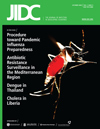Relationship of drug resistance to phylogenetic groups of E. coli isolates from wound infections
DOI:
https://doi.org/10.3855/jidc.66Keywords:
Drug resistance, E. coli, wounds, phylogenetic groupsAbstract
Background: Drug resistance is a major problem in Escherichia coli isolated from surgical wound infections. In this study, we evaluated relationship between phylogenicity and drug resistance.
Methodology: A total of 29 multi-drug resistant (MDR) E. coli isolates of known drug resistance genes and integron profile were selected for the present study. Triplex PCR was conducted for phylogenetic classification of these isolates into four established phylogenetic groups: A, B1, B2 and D. Statistical analysis was done to determine the association of different drug resistance genes and integrons with the phylogenetic groups.
Results: Most of the isolates (44.8%) belonged to phylogenetic group A followed by group B2 and D (24.1% each) and group B1 (6.9%).
Conclusions: There is a definitive relationship between drug resistance and various phylogenetic groups of E. coli infecting wounds. A shift towards phylogenetic group A might be observed with an increasing drug resistance profile.
Downloads
Published
How to Cite
Issue
Section
License
Authors who publish with this journal agree to the following terms:
- Authors retain copyright and grant the journal right of first publication with the work simultaneously licensed under a Creative Commons Attribution License that allows others to share the work with an acknowledgement of the work's authorship and initial publication in this journal.
- Authors are able to enter into separate, additional contractual arrangements for the non-exclusive distribution of the journal's published version of the work (e.g., post it to an institutional repository or publish it in a book), with an acknowledgement of its initial publication in this journal.
- Authors are permitted and encouraged to post their work online (e.g., in institutional repositories or on their website) prior to and during the submission process, as it can lead to productive exchanges, as well as earlier and greater citation of published work (See The Effect of Open Access).








